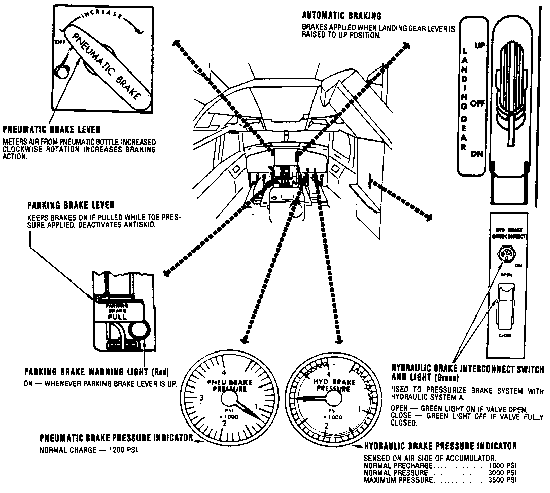
BOEING 727 LANDING GEAR & BRAKES
Landing Gear System...

The Boeing 727 is equipped with tricycle, retractable landing gear. The landing gear is powered by Hydraulic System A or, alternatively, can be extended manually. Both the main wheel and nosewheel wheel-well doors are closed when the gear is extended. During the course of normal operations, the wheel-well doors will only open when the landing gear is in transit. Sequencing valves open gear doors, extend or retract the gear, then close the doors. Manual gear door release mechanisms are located in each of the main wheel wells to allow for maintenance and inspection of the wheel wells.
The tail skid lowers and locks once the landing gear lever is placed in the DOWN position. Squat switches on the left main landing gear prevent inadvertent landing gear retraction on the ground.
The left main gear strut must be extended (weight off the strut) before the gear will retract. Brake pressure is automatically applied to stop wheel rotation before the wheels retract into the wheel wells. Wheel wells are fire detection systems, but no extinguishing is provided. In the event of a wheel well fire in flight which is normally caused by overheating brakes, the crew should lower the landing gear and leave the gear doors open. Gear doors are held open by lowering the gear and placing the lever in the DOWN position. Then, momentarily move the gear handle UP (which opens the doors). Finally, place the gear handle in the OFF position as soon as the gear door light illuminates. This will remove all hydraulic pressure which in turn will leave the doors open and the landing gear down.
Landing gear may be lowered manually in the event of Hydraulic System A failure through three fittings on the cockpit floor that provide direct operation of each gear and its doors by use of a handcrank. Once the crank is turned in the proper direction and the correct number of times, the gear doors and gear will unlock and the landing gear will free-fall into position. The crank is then turned in the opposite direction to lock the gear in the down position. The landing gear handle must be in the OFF position before gear is lowered manually. Three viewing ports in the passenger cabin floor verify the gear is down and locked. The gear is down and locked when two adjacent red stripes are aligned in the viewing port.
Wheel Brake System...

The Boeing 727 has five lockout-deboost valves which provide leak protection and reduction of main hydraulic system pressure to a pressure that is lower for the brakes. There is one valve on the nosewheel and two on each main gear. The purpose of these lockouts is to prevent depletion of the hydraulic system should a leak occur on the brake side of the valve. The parking brake should be set during preflight so that the main gear deboost valves can be checked. As nose brakes cannot be applied at speeds of less than 15 knots, the deboost valve will indicate in a red band during preflight.
Each tire has a fusible plug which will melt if the tire becomes overly hot from a brake overheat. This allows the tire to deflate rather than blow out. Tires are filled with nitrogen to reduce the fire hazard.
Brake wear indicators on each of the brakes should be checked during preflight. The brakes must be applied for this.
The 727's brake system has a hydraulic accumulator that absorbs pressure surges and stores hydraulic pressure for limited braking if main hydraulic pressure is lost. The normal precharge for this accumulator is 1,000 PSI and must be checked with brakes and pumps OFF. A brake system pressure of ZERO would indicate loss of accumulator precharge pressure.
The Boeing 727 uses an anti-skid system to increase brake effectiveness and to prevent skids. This system "compares" symmetrically-paired wheels to ensure they are rotating at the same speed. If they aren't brake pressure is automatically readjusted. Should wheel suddenly slow or stop spinning, brake pressure to that wheel is automatically released. No pressure can be applied to the brakes in flight with the anti-skid on.
As a backup, the 727 is fitted with a pneumatic braking system should hydraulic pressure be lost. The lines for this system are separate from the normal brake system. When the pneumatic brake handle is turned clockwise, air pressure is applied to a transfer tube that pressurizes the hydraulic fluid for the main gear brakes. Anti-skid is inoperative when using pneumatic brakes and no differential braking is available. If using the pneumatic system, avoid pedal braking as the two systems may neutralize each other.